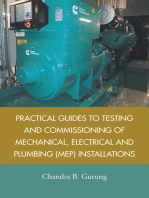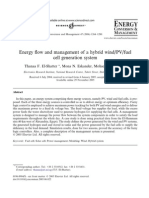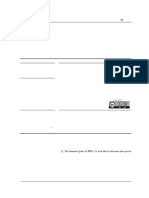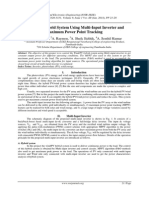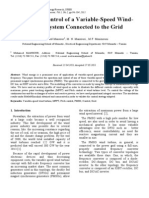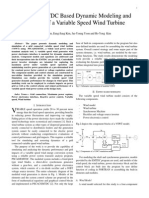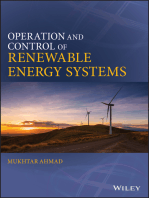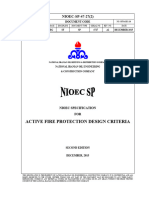Conf 1
Conf 1
Uploaded by
sujithadharani9813Copyright:
Available Formats
Conf 1
Conf 1
Uploaded by
sujithadharani9813Copyright
Available Formats
Share this document
Did you find this document useful?
Is this content inappropriate?
Copyright:
Available Formats
Conf 1
Conf 1
Uploaded by
sujithadharani9813Copyright:
Available Formats
Step-down DC/DC
Converter
Batteries
Bi-directional
DC/DC
Converter
DC
Load
Wind generator
Design and Implementation of a Digital Power
Converter for Wind Energy Conversion
Chih-Chiang Hua
Department of Electrical Engineering
National Yunlin University of Science & Technology
Douliou, Yunlin, Taiwan, ROC
huacc@yuntech.edu.tw
Cheng-Zong He
Department of Electrical Engineering
National Yunlin University of Science & Technology
Douliou, Yunlin, Taiwan, ROC
g9812729@yuntech.edu.tw
AbstractThis paper presents the design and implementation of
power converter for wind generator. The proposed system
consists of a wind generator, a buck converter, a bi-directional
dc/dc converter and lead-acid battery. The wind generator is the
main power source of the system, and the battery is used for
energy storage and power compensation. In order to make the
wind power generator produce the maximum power, the battery
is charged or discharged through the bi-directional dc/dc
converter. By adjusting the duty of the power converter, the
charging efficiency of batteries can be improved. A digital signal
processor is used to realize the system controller. The system
controls the duty cycle of the buck converter to accomplish the
maximum power tracking. Finally, a 100W wind energy
conversion system is built and experimental results are provided
to verify theoretical analysis and feasibility of the wind power
conversion system.
Keywords- wind generator, maximum power point tracking,
renewable energy.
I. INTRODUCTION
In recent years, as economy is growing rapidly, oil demand
has been increasing year by year. The petroleum energy is
limited, the oil price has reflected on the market, not only result
in a lot of problems, but also emissions of carbon dioxide,
which affects the Earth's ecological environment. We have to
find new alternative sources of energy to reduce the use of
fossil energy and carbon dioxide emissions. Therefore, the
development and use of renewable energy is very important,
governments should promote the use of renewable energy.
Renewable energy from wind power, solar power, hydropower,
biomass power, geothermal power.etc., has the advantages of
low pollution, made easy, endless. However, it suffers from
low energy density, vulnerability to seasonal changes and
geographical environment, power output variations, lack of
stability. Based on earlier considerations and development,
wind power technology has become mature technology and the
most promising renewable energy. According to the "Kyoto
Protocol"[1], Taiwan government made a commitment to
reduce the emissions of carbon dioxide through the
"Sustainable Energy Policy"[2].
Because of Taiwan`s geographical location, an island-type
climate with abundant rains and storms, making the islands full
Fig. 1. The diagram of the proposed system.
of wind energy in coastal, mountain and other areas. This is
very advantageous for the development of wind power.
Due to the instability and intermittent characteristics of
wind energy, it can`t provide a constant or stable power output.
The wind turbine output power changes with the wind speed.
However, wind turbine will have maximum power points under
different conditions; thus, maximum power point tracking
(MPPT) is a very important technology for the wind power
system. Many MPPT methods have been developed, mostly
dominated by perturbation and observation method [3], the
advantages are only few parameters are required to measure
and easy to control the maximum power point, often applied to
the wind power generation system for enhancing power
capacity. Controlling the duty cycle of power switch can
change the wind power system output voltage. The output
powers before and after disturbances are compared and used to
control the system. The system can be operated near the MPP`s.
However, the oscillations around the MPP`s result in power
loss and low efficiency.
The proposed system is implemented by using a digital
signal processor (DSP) as the controller to achieve maximum
power tracking and system control. Fig. 1 shows the block
diagram of the proposed system including a wind generator, a
DC buck converter, a DC bidirectional buck converter and
batteries. The bi-direz8ctional buck-boost converter is used to
control the power flow from batteries to dc load and from wind
generator to batteries, thus the power compensation for the
1398 978-1-4244-8756-1/11/$26.00 c 2011 IEEE
Wind generator rotor speed(rpm)
V1
V2
V3
V4
V4 > V3 > V2 > V1
W
i
n
d
g
e
n
e
r
a
t
o
r
o
u
t
p
u
t
p
o
w
e
r
(
W
)
Maximum
Power Line
Maximum
Power Point
PMSG Vdc
Rectifier L1
Cr
Q1
D1
C1
C2 C3 Q2
L2
Q3
D3
D2
Battery
Buck dc/dc converter
Bi-directional dc/dc converter
Load
VG
Vbat
Fig. 2. Wind power curves at various speeds.
system is achieved with proper control. The buck converter is
controlled to provide a DC voltage output to the load.
II. CHARACTERISTICS OF WINDGENERATOR
Wind energy mainly produced by the flow of air, which
results from the cold air and hot air due to the heating from the
sunlight. The wind turbine blades are driven by the wind, thus
the rotation of the generator rotor is used to produce electricity.
Then the wind energy is converted into mechanical energy, and
the mechanical energy is converted into electrical energy. Not
all wind flowing through the wind turbine blades can be
converted into wind energy, the theoretical maximum
conversion efficiency is about 59% [3]. The efficiency for most
wind turbine is about 30 - 50%, which is determined by the
number of leaves and the design of aerodynamic. The overall
efficiency after power converter is about 20 - 45%.
The resulting wind after wind turbine blades capturing the
wind energy, a speed difference exists between the upwind and
downwind, and the mathematical expression is as
} {
2
1 2 2
O M
V V m P =
-
(1)
where PM is the captured wind energy by wind turbine blades,
which is also the mechanical energy that drives the rotor; V is
the air flow velocity before the wind turbine blades(m/s), Vo is
the air flow velocity after the wind turbine blades(m/s),
-
m
is
the flow rate (mass flow rate) (kg/s), the expression is as
follows:
2
O
V V
A m
+
=
-
(2)
where is the air density (kg/m3), a cross-sectional area of
fluid through the (m2), substitute (2) into (1), we can get
} ){
2
(
2
1 2 2
O
O
M
V V
V V
A P
+
=
(3)
(3) can be simplified
2
1 1
2
1
2
3
(
(
|
.
|
\
|
|
.
|
\
|
+
=
V
V
V
V
AV P
O O
M
(4)
Fig. 3. Proposed system circuit.
R is rotating plane radius of wind turbine blades (m), (4) can be
expressed as
2
1 1
2
1
2
3 2
(
(
|
.
|
\
|
|
.
|
\
|
+
=
V
V
V
V
V R P
O O
M
t
(5)
(5) can be rewritten as
P M
C V R P
3 2
2
1
t =
(6)
where
2
1 1
2
(
(
|
.
|
\
|
|
.
|
\
|
+
=
V
V
V
V
C
O O
P
(7)
In (7), the CP is wind turbine power coefficient or the rotor
efficiency, by (6) we know that the wind energy captured by
the leaves is proportional to the size of CP. CP is limited by the
aeromechanics and it is maximum value is 16/27 in theory. In
other words, the maximum efficiency of captured wind energy
by wind turbine blades is about 59%.
According to the wind energy conversion principle, the
wing tip speed ratio (tip speed ratio) , said the top speed oI
wind turbine blades and wind speed ratio, and its expression is
as follows
V
R e
=
(8)
where is the generator rotor angular velocity (rad/s),
changes with the CP.
Theoretically, the maximum power point of a generator
corresponds to the TSR at different wind speeds. Therefore,
when the wind speed is constant, a non-linear relationship can
be obtained between the generator output power and the rotor
speed as shown in Fig. 2.
III. TOPOLOGIES OF THE PROPOSEDSYSTEM
Fig. 3 shows that proposed system circuit, including the
wind power generator, the DC-DC buck converters and DC-
DC bidirectional converter. Wind generator output through the
three-phase rectifier, buck converter feeding DC voltage
reduced to the size required, and DC bidirectional converter is
responsible for the energy stored in the battery and power
compensation.
2011 6th IEEE Conference on Industrial Electronics and Applications 1399
Battery
buck
converter
charging
current
L2
C2
Q2
Q3
D3
D2
C3
+
-
buck
converter
discharging
current
Battery
L2
C2
Q2
Q3
D3
D2 C3
+
-
Start
Sense
Vbuck . Ibuck
Pn+1 > Pn
Vn+1 > Vn Vn+1 > Vn
Di+1=Di+D
Di+1=Di-D Di+1=Di+D
Di+1=Di-D
No
No
Yes
Yes
Return
V
dc
L
1
V
wind
Q
1
D
1
C
1
+
-
Wind speed(m/s)
A
B
P
L
P
C
P
Battery charge
power
Load power
W
i
n
d
t
u
r
b
i
n
e
p
o
w
e
r
c
a
p
a
c
i
t
y
(
W
)
(a) Buck mode
(b) Boost mode
Fig. 4. Bi-directional converter operation modes.
(a) Buck mode. (b) Boost mode.
A. DC-DC Buck converter
The buck converter step-down voltage to the desired level
from wind generator output, and sensor buck converter output
voltage and current, then achieve maximum power output by
duty cycle modulation switching.
B. DC-DC Bi-directional converter
The operation modes of the bi-directional dc/dc converter
[5] are shown in Fig. 4. The bi-directional dc/dc converter has
two operation modes. Buck mode (energy storage) and the
boost mode (power compensation).Buck mode, the battery
charge, and buck converter output is bi-directional converter
input, the battery is the load, as shown in Fig. 4(a).Boost mode,
the battery is discharged, buck converter output is bi-
directional converter output, the battery is input source, as
shown in Fig 4(b).
IV. CONTROL STRATEGIES
A. Maximum Power Point Tracking
The perturbation and observation method can quickly
achieve the maximum power point tracking. Fig. 5 shows the
flow chart of the maximum power tracking. The output voltage
and current of the buck converter is controlled with MPPT, the
duty cycle of switch S1 is adjusted to achieve maximum power
tracking.
The switch duty modulation of the converter is controlled
with PI control, and duty cycle can be expressed as
1 n n p i
d d k error k error dt
=
)
(10)
Fig. 5. Maximum power tracking control flow chart.
Fig. 6. Buck converter Structure.
Fig. 7. Wind turbine output power and load demand diagram.
dn is the converter duty cycle at step N, dn-1 is the
converter duty cycle at step N-1, error is the command and the
controlled plant output error volume, Kp and Ki are
proportional and integral gain [6].
B. Bi-directional converter control strategy
Fig. 7 shows the relationship between the wind generator
output power and load demand. When the wind speed increases,
wind turbine power output capacity will correspondingly
increase. The system supplies the load as shown in Fig. 7. The
wind turbine power capacity can be divided into two parts: PL
is the load power, the load power is first provided by the wind
turbine output power; PC is the battery charging power.
Regions A, B represent power distribution and system control
for In region A, the wind turbine output power is greater than
1400 2011 6th IEEE Conference on Industrial Electronics and Applications
Digital
signal
simulator
2407
DC Server
Motor
Wind
Generator
DC
output
Wind Speed
0 ~ 1000rpm
Labview
Control Interface
DSP
Driver
V
dc
PWM
Vdc
Vbat
IL
IB
Vdc
Vbat
IL
IB
Vdc
Vbat
IL
IB
Fig. 8. Wind power system simulation schematic diagram.
Fig. 9. Maximum power tracking.(CH1:Vdc 2V/divCH2:PWM 20V/div)
Fig. 10. Generator output power and output voltage curve.
the load power, thus the extra energy can be used to
charge the battery; In region B, the wind turbine output
power is lower than the load power, and the required power
can be supplied by the battery.
V. EXPERIMENTAL RESULTS
This paper proposes a wind energy conversion system,
including the DC motor and synchronous generator rated
150W. The DC motor directly drive the generator, controlled
by the Labview interface to simulate the wind speed DC
motor speed changes, as shown in Fig. 8
(a) (CH1:Vdc 10V/divCH2:Vbat 10V/divCH3:IL 5A/div
CH4:IB 2A/div)
(b) (CH1:Vdc 10V/divCH2:Vbat 5V/divCH3:IL 5A/divCH4:IB
5A/div)
(C) (CH1:Vdc 10V/divCH2:Vbat 5V/divCH3:IL 2A/divCH4:IB
5A/div)
Fig. 11. Experimental waveforms.(a)60W. (b)80W. (C)100W.
2011 6th IEEE Conference on Industrial Electronics and Applications 1401
A. MPPT
Fig. 9 shows the transient response for the proposed
system with MPPT.
B. Wind turbine output power
Fig. 10 shows generator output power and voltage under
different wind speeds. The generator output power varies
with wind speed, and there is always a maximum power
point for different wind speeds which can be tracked by the
MPPT control.
C. Load Test
Fig. 11 shows the measured waveforms for the proposed
system under the load conditions of 60W, 80W, and 100W,
respectively. A stable output can be obtained with the
proposed system.
VI. CONCLUSION
This paper presents a wind power system, consisting of a
DSP for the system control, a PI control step-down
converter and a bi-directional switching converter. The
system control the duty cycle to achieve power
compensation. The use of bi-directional converter can make
the appropriate wind energy distribution system, and can
store the excess energy to the battery. When the wind speed
is low, the battery can supply power to the load through the
bi-directional converter. Maximum power tracking is used
to achieve the most effective use of wind energy.
REFERENCES
[1] United Nations, 'Kyoto Protocol to the United Nations Framework
Convention on Climate Change, 1998.
[2] Sustainable Energy Policy, 2008.
[3] Ching-Tsai Pan, and Yu-Ling Juan,A Novel Sensorless MPPT
Controller for a High-Efficiency Microscale Wind Power
Generation System, IEEE Trans. on Energy Conversion, Vol. 25,
No. 1, March 2010.
[4] Vivek Agarwal,Rakesh Kumar Aggarwal,Pravin Patidar,and Chetan
Patki,A Novel Scheme for Rapid Tracking of Maximum Power
Point in Wind Energy Generation Systems, IEEE Trans. on Energy
Conversion, Vol. 25, No. 1, March 2010.
[5] S. Hashimoto, M. Nitta, T. Tani, and T. Yachi, 'A Stand-alone
Wind Turbine Generation System for a Small-scale Radio Base
Station, The 25th International Telecommunications Energy
Conference, pp. 404-409, 2003.
[6] T. F. Wu, C. H. Chang, and Y. K. Chen, 'A Fuzzy-Logic-
Controlled Single-Stage Converter for PV-Powered Lighting
System Applications, IEEE Transactions on Industrial Electronics,
Vol. 47, No. 2, pp. 287-296, April 2000.
1402 2011 6th IEEE Conference on Industrial Electronics and Applications
You might also like
- Practical Guides to Testing and Commissioning of Mechanical, Electrical and Plumbing (Mep) InstallationsFrom EverandPractical Guides to Testing and Commissioning of Mechanical, Electrical and Plumbing (Mep) InstallationsRating: 4 out of 5 stars4/5 (4)
- Introduction to Electricity Supply and Regulation in IndiaFrom EverandIntroduction to Electricity Supply and Regulation in IndiaNo ratings yet
- Study of a reluctance magnetic gearbox for energy storage system applicationFrom EverandStudy of a reluctance magnetic gearbox for energy storage system applicationRating: 1 out of 5 stars1/5 (1)
- Visio-Refinery Block DiagramDocument1 pageVisio-Refinery Block Diagramankur2061100% (1)
- Coke Oven Heating RegimeDocument44 pagesCoke Oven Heating RegimeCma Anita Singh Gautam78% (9)
- 19.wind Power SystemDocument4 pages19.wind Power SystemSanthosh KumarNo ratings yet
- Volume (8) Issue (4) 493-507Document15 pagesVolume (8) Issue (4) 493-507Seid BegovicNo ratings yet
- Power and Energy Analysis of Commercial Small Wind Turbine SystemsDocument6 pagesPower and Energy Analysis of Commercial Small Wind Turbine SystemsKamal DrawilNo ratings yet
- Hybrid Wind Diesel Energy System Using Matlab Simulation: ISO 9001:2008 CertifiedDocument9 pagesHybrid Wind Diesel Energy System Using Matlab Simulation: ISO 9001:2008 Certifiedsatya_vanapalli3422No ratings yet
- Wind EnergyDocument8 pagesWind EnergyValenitnNo ratings yet
- New Control Strategies of A Small Size Wind Generation System For Battery ChargingDocument6 pagesNew Control Strategies of A Small Size Wind Generation System For Battery ChargingZellagui EnergyNo ratings yet
- Control The Flywheel Storage System by Fuzzy Logic Associated With The Wind GeneratorDocument7 pagesControl The Flywheel Storage System by Fuzzy Logic Associated With The Wind GeneratorhassenbbNo ratings yet
- 127Document7 pages127Salem Al HendyNo ratings yet
- Continuous Variable Speed Wind Turbine: Transmission Concept and Robust ControlDocument17 pagesContinuous Variable Speed Wind Turbine: Transmission Concept and Robust ControlDork654651No ratings yet
- Wind Power Generation Technology PDFDocument10 pagesWind Power Generation Technology PDF1balamanianNo ratings yet
- Power Maximization Control of Small Wind System Using Permanent Magnet Synchronous GeneratorDocument13 pagesPower Maximization Control of Small Wind System Using Permanent Magnet Synchronous GeneratorhassenbbNo ratings yet
- Power Electronics As Efficient Interface in Dispersed Power Generation SystemsDocument11 pagesPower Electronics As Efficient Interface in Dispersed Power Generation SystemsnmotanNo ratings yet
- Modelling and Simulation: Wind Turbine GeneratorDocument7 pagesModelling and Simulation: Wind Turbine GeneratorEléctrico IngenieríaNo ratings yet
- Design and Modeling of Wind Energy Conversion System Based On PMSG Using MPPT TechniqueDocument5 pagesDesign and Modeling of Wind Energy Conversion System Based On PMSG Using MPPT TechniqueijsretNo ratings yet
- Technologies For Power Generation From WindDocument4 pagesTechnologies For Power Generation From WindSEP-PublisherNo ratings yet
- Energy Flow and Management of A Hybrid wind/PV/fuel Cell Generation SystemDocument17 pagesEnergy Flow and Management of A Hybrid wind/PV/fuel Cell Generation SystemPriya SingNo ratings yet
- Wind Generation System For Charging BatteriesDocument6 pagesWind Generation System For Charging BatteriesAmit RanjanNo ratings yet
- Jjmie: Modeling and Optimization of Wind Turbine Driving Permanent Magnet Synchronous GeneratorDocument6 pagesJjmie: Modeling and Optimization of Wind Turbine Driving Permanent Magnet Synchronous GeneratorhassenbbNo ratings yet
- 1.1 Problem BackgroundDocument29 pages1.1 Problem BackgroundSabari RajanNo ratings yet
- An Efficient Hybrid Reconfigurable Wind Gas Turbine Power Management System Using MPPT AlgorithmDocument10 pagesAn Efficient Hybrid Reconfigurable Wind Gas Turbine Power Management System Using MPPT AlgorithmInternational Journal of Power Electronics and Drive SystemsNo ratings yet
- Control Strategy For HVDC Interconnected DC-based Offshore Wind FarmDocument6 pagesControl Strategy For HVDC Interconnected DC-based Offshore Wind FarmTruong HoaNo ratings yet
- Power Electronics in Wind Turbine SystemsDocument19 pagesPower Electronics in Wind Turbine SystemsAnas AlzoubiNo ratings yet
- Modeling and Simulation of Dfig To Grid Connected Wind Power Generation Using MatlabDocument12 pagesModeling and Simulation of Dfig To Grid Connected Wind Power Generation Using MatlabIAEME PublicationNo ratings yet
- Volume8Issue4493 507Document16 pagesVolume8Issue4493 507Mark FordNo ratings yet
- Control of Hybrid System Using Multi-Input Inverter and Maximum Power Point TrackingDocument8 pagesControl of Hybrid System Using Multi-Input Inverter and Maximum Power Point TrackingInternational Organization of Scientific Research (IOSR)No ratings yet
- Estimacion CPDocument6 pagesEstimacion CPEdjavier CastilloNo ratings yet
- Article - ALVES EVO Marco TulioDocument12 pagesArticle - ALVES EVO Marco TulioMenyimana PhilotaireNo ratings yet
- Transient Analysis and Modeling of Wind Generator During Power and Grid Voltage DropDocument8 pagesTransient Analysis and Modeling of Wind Generator During Power and Grid Voltage DropIAEME PublicationNo ratings yet
- Incremental Conductance Technique For A Hybrid Wind - Solar Energy SystemDocument4 pagesIncremental Conductance Technique For A Hybrid Wind - Solar Energy SystemHanumante AkshayNo ratings yet
- Impact of The Design Method of Permanent Magnets Synchronous Generators For Small Direct Drive Wind Turbines For Battery OperationDocument5 pagesImpact of The Design Method of Permanent Magnets Synchronous Generators For Small Direct Drive Wind Turbines For Battery OperationhassenbbNo ratings yet
- Study and Control of A Variable-Speed Wind-Energy System Connected To The GridDocument9 pagesStudy and Control of A Variable-Speed Wind-Energy System Connected To The GridhassenbbNo ratings yet
- Vertical Axis Wind Turbine ImprovementDocument11 pagesVertical Axis Wind Turbine Improvementahmad rosyidNo ratings yet
- Pitch Controlled Variable Speed For WTDocument10 pagesPitch Controlled Variable Speed For WTArikson SantanaNo ratings yet
- (Ajay Singh) Review On Control Techniques For VSWT NewDocument6 pages(Ajay Singh) Review On Control Techniques For VSWT NewAjay SinghNo ratings yet
- Hybrid Wind /solar Power SystemDocument7 pagesHybrid Wind /solar Power SystemPiyush SinghNo ratings yet
- Modeling and Control of Direct Drive Variable Speed Stand-Alone Wind Energy Conversion SystemsDocument6 pagesModeling and Control of Direct Drive Variable Speed Stand-Alone Wind Energy Conversion SystemsSamundra GurungNo ratings yet
- SWHMDocument9 pagesSWHMParthasarothi SikderNo ratings yet
- Model and Control of A DC Microgrid Made Up by Solar and WindDocument5 pagesModel and Control of A DC Microgrid Made Up by Solar and WindUpendra VarmaNo ratings yet
- Using Y-Source Network As A Connector Between Turbine and Network in The Structure of Variable Speed Wind TurbineDocument15 pagesUsing Y-Source Network As A Connector Between Turbine and Network in The Structure of Variable Speed Wind TurbineInternational Journal of Power Electronics and Drive SystemsNo ratings yet
- Application Research of Maximum Wind-Energy Tracing Controller Based Adaptive Control Strategy in WECSDocument5 pagesApplication Research of Maximum Wind-Energy Tracing Controller Based Adaptive Control Strategy in WECSEngr Tahir Iqbal AwanNo ratings yet
- Chapter 1Document72 pagesChapter 1sunilkumareceNo ratings yet
- WindpowerDocument24 pagesWindpowerDouglasNo ratings yet
- Dynamic Modeling of Wind Power Generation: H Ector A. Pulgar-Painemal and Peter W. SauerDocument6 pagesDynamic Modeling of Wind Power Generation: H Ector A. Pulgar-Painemal and Peter W. SauerkfaliNo ratings yet
- Mathematical Modelling of Wind Turbine in A Wind Energy Conversion System: Power Coe Cient AnalysisDocument10 pagesMathematical Modelling of Wind Turbine in A Wind Energy Conversion System: Power Coe Cient AnalysisJose Antonio GdNo ratings yet
- A Hybrid WindDocument52 pagesA Hybrid WindjohnsimilNo ratings yet
- 4826 Musyafa Ep Zanzibar AliDocument12 pages4826 Musyafa Ep Zanzibar AliJoao Carlos DrumondNo ratings yet
- Power Electronics in Renewable Energy SystemsDocument17 pagesPower Electronics in Renewable Energy SystemsPaulius Bruneika100% (1)
- PSCAD Based Dynamic ModelingDocument7 pagesPSCAD Based Dynamic ModelingLalith KrishnanNo ratings yet
- 14.dynamic Modeling, Design and Simulation of A Windfuel Cellultracapacitor-Based Hybrid Power GeDocument16 pages14.dynamic Modeling, Design and Simulation of A Windfuel Cellultracapacitor-Based Hybrid Power GeYellaturi Siva Kishore ReddyNo ratings yet
- Doubly-Fed Full-Controlled Induction Wind Generator For Optimal Power UtilisationDocument7 pagesDoubly-Fed Full-Controlled Induction Wind Generator For Optimal Power Utilisationrida1001No ratings yet
- Dynamic Modeling, Design and Simulation of A Wind/fuel Cell/ultra-Capacitor-Based Hybrid Power Generation SystemDocument16 pagesDynamic Modeling, Design and Simulation of A Wind/fuel Cell/ultra-Capacitor-Based Hybrid Power Generation SystemKamal SharmaNo ratings yet
- Fuzzy Sliding Mode Power Control For Wind Power Generation Systems Connected To The GridDocument14 pagesFuzzy Sliding Mode Power Control For Wind Power Generation Systems Connected To The GridInternational Journal of Power Electronics and Drive SystemsNo ratings yet
- A New Method of Maximum Power Point Tracking For DFIG Based Wind TurbineDocument7 pagesA New Method of Maximum Power Point Tracking For DFIG Based Wind Turbinebalaji06202No ratings yet
- Offshore Wind Energy Generation: Control, Protection, and Integration to Electrical SystemsFrom EverandOffshore Wind Energy Generation: Control, Protection, and Integration to Electrical SystemsNo ratings yet
- Power Systems-On-Chip: Practical Aspects of DesignFrom EverandPower Systems-On-Chip: Practical Aspects of DesignBruno AllardNo ratings yet
- Feed Forward ControlDocument19 pagesFeed Forward Controlsujithadharani9813No ratings yet
- Resonant ConverstionDocument27 pagesResonant Converstionsujithadharani9813No ratings yet
- FACTS Study Notes by AaruDocument71 pagesFACTS Study Notes by Aarusujithadharani9813No ratings yet
- Thyristor Controlled Series Compensator-Based Controller Design Employing Genetic Algorithm: A Comparative StudyDocument10 pagesThyristor Controlled Series Compensator-Based Controller Design Employing Genetic Algorithm: A Comparative Studysujithadharani9813No ratings yet
- Eaf 01 110Document2 pagesEaf 01 110PUCK CMNo ratings yet
- Vikas Floating Solar PVDocument18 pagesVikas Floating Solar PVShailesh SinghNo ratings yet
- Series 6 Optimal Module Size Factsheet PDFDocument1 pageSeries 6 Optimal Module Size Factsheet PDFsdfsdfNo ratings yet
- Renewable Energy THD Exam SS21Document2 pagesRenewable Energy THD Exam SS21phạmhữuTríNo ratings yet
- Fluid Mechanics ExamDocument2 pagesFluid Mechanics ExamAdamsNo ratings yet
- 110 Top Most Economics of Power GENERATION - Electrical Engineering Objective Type Questions and AnswersDocument19 pages110 Top Most Economics of Power GENERATION - Electrical Engineering Objective Type Questions and AnswersHassan SayedNo ratings yet
- Chapter 7. Tidal PowerDocument4 pagesChapter 7. Tidal PowerArchi WsmNo ratings yet
- Alstom HRSGDocument16 pagesAlstom HRSGmkarthikeyan023No ratings yet
- Dr. Eng. Mohammad Karman: Profile SkillsDocument2 pagesDr. Eng. Mohammad Karman: Profile SkillsHussein WassofNo ratings yet
- Fuction1 MANAGE THE OPERATION OF PROPULSION PLANT UPDATEDocument4 pagesFuction1 MANAGE THE OPERATION OF PROPULSION PLANT UPDATEAdii100% (1)
- D-6409f - Marketing C2000 GAS HSK78Document2 pagesD-6409f - Marketing C2000 GAS HSK78Edwin Fernando Ariza QuirogaNo ratings yet
- Aaru - SCADA Operator Console PDFDocument3 pagesAaru - SCADA Operator Console PDFArumugam RajendranNo ratings yet
- R1 WGFE20-0047 Training Text for M701JAC GT Disassembly Scope of Planned MaintenanceDocument37 pagesR1 WGFE20-0047 Training Text for M701JAC GT Disassembly Scope of Planned Maintenancebmw316100% (4)
- Case Study 8 - Indonesia Diesel Power PlantDocument1 pageCase Study 8 - Indonesia Diesel Power Plantsyedfarooque goltensNo ratings yet
- Lodine Filters in Nuclear Power Stations: April 1977 Laboratorium Tür Aerosolphysik Und Filtertechnik KFK 2449Document153 pagesLodine Filters in Nuclear Power Stations: April 1977 Laboratorium Tür Aerosolphysik Und Filtertechnik KFK 2449sagisNo ratings yet
- Pump Sizing SpreadsheetDocument2 pagesPump Sizing Spreadsheetandrew rachmanNo ratings yet
- STEAM BLOWING PROCEDURE - MPL Phase-1 & 2 PDFDocument8 pagesSTEAM BLOWING PROCEDURE - MPL Phase-1 & 2 PDFm_ganesh1983No ratings yet
- Estimation of Power Generation Potential of Agricultural Based Biomass Spiceis and Coal-Biomass Mixed BriquettesDocument57 pagesEstimation of Power Generation Potential of Agricultural Based Biomass Spiceis and Coal-Biomass Mixed Briquettesmantu044No ratings yet
- Miscellaneous Accessories: Submittal A-338GDocument2 pagesMiscellaneous Accessories: Submittal A-338Gfernandoperdomo20-1No ratings yet
- Airbreathing PropulsionDocument1 pageAirbreathing PropulsionPradeep KumarNo ratings yet
- Turbocharger Choice: MAN B&W Diesel A/S S60MC-C Project GuideDocument11 pagesTurbocharger Choice: MAN B&W Diesel A/S S60MC-C Project GuideАлександр КозыревNo ratings yet
- MS Samsung Slim Duct PDFDocument2 pagesMS Samsung Slim Duct PDFMacSparesNo ratings yet
- Observation Table For TrialsDocument3 pagesObservation Table For TrialsAbhishek KhatavkarNo ratings yet
- Combined Production of Heat and PowerDocument234 pagesCombined Production of Heat and Powerjegjegt100% (1)
- Novec 1230 All CalculationsDocument5 pagesNovec 1230 All CalculationsKhyle Laurenz DuroNo ratings yet
- Nioec SP 47 27Document29 pagesNioec SP 47 27Shahram GhassemiNo ratings yet
- MEE551 NoteDocument48 pagesMEE551 NoteOsarobo IghodaroNo ratings yet
- Cost 3 TPH 12kg Fo Fired Boiler p0Document3 pagesCost 3 TPH 12kg Fo Fired Boiler p09913489806No ratings yet
